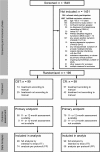Negative symptoms of schizophrenia as primary target of cognitive behavioral therapy: results of the randomized clinical TONES study
- PMID: 21860053
- PMCID: PMC3160126
- DOI: 10.1093/schbul/sbr073
Negative symptoms of schizophrenia as primary target of cognitive behavioral therapy: results of the randomized clinical TONES study
Abstract
Clinical studies on cognitive behavioral therapy (CBT) that include schizophrenia patients primarily on the basis of negative symptoms are uncommon. However, those studies are necessary to assess the efficacy of CBT on negative symptoms. This article first gives an overview of CBT on negative symptoms and discusses the methodological problems of selecting an adequate control group. Furthermore, the article describes a clinical study (the TONES-Study, ISRCTN 25455020), which aims to investigate whether CBT is specifically efficacious for the reduction of negative symptoms. This multicenter randomized clinical trial comparing CBT with cognitive remediation (CR) for control of nonspecific effects is depicted in detail. In our trial, schizophrenia patients (n = 198) participated in manualized individual outpatient treatments. Primary outcome is the negative syndrome assessed with the positive and negative syndrome scale, analyzed with multilevel linear mixed models. Patients in both groups moderately improved regarding the primary endpoint. However, against expectation, there was no difference between the groups after treatment in the intention to treat as well as in the per-protocol analysis. In conclusion, psychotherapeutic intervention may be useful for the reduction of negative symptoms. However, there is no indication for specific effects of CBT compared with CR.
Figures


References
-
- Häfner H, an der Heiden W. The course of schizophrenia in the light of modern follow-up studies: the ABC and WHO studies. Eur Arch Psychiatry Clin Neurosci. 1999;249(suppl 4):14–26. - PubMed
-
- Carpenter WT, Heinrichs DW, Wagman AM. Deficit and nondeficit forms of schizophrenia: the concept. Am J Psychiatry. 1988;145:578–583. - PubMed
-
- Peralta V, Cuesta MJ. Clinical models of schizophrenia: a critical approach to competing conceptions. Psychopathology. 2000;33:252–258. - PubMed
-
- Lencz T, Smith CW, Auther A, Correll CU, Cornblatt B. Nonspecific and attenuated negative symptoms in patients at clinical high-risk for schizophrenia. Schizophr Res. 2004;68:37–48. - PubMed
Publication types
MeSH terms
Associated data
LinkOut - more resources
Full Text Sources
Medical

